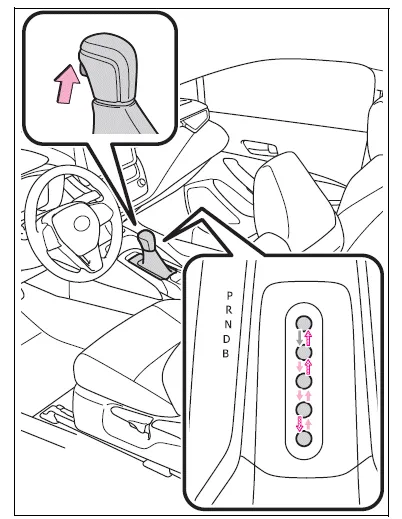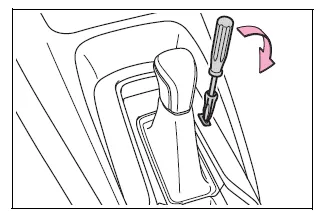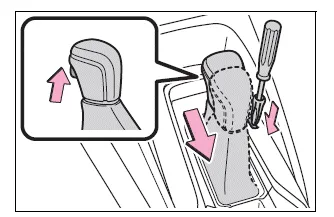Toyota Corolla (E210) 2019-2025 Owners Manual / Driving / Driving procedures / Continuously variable transmission
(vehicles without paddle
shift switches)
Toyota Corolla (E210): Continuously variable transmission (vehicles without paddle shift switches)
Select the shift position depending on your purpose and situation.
Shift position purpose and functions
P - Parking the vehicle/
starting the engine
R - Reversing
N - Neutral
(Condition in which the
power is not transmitted)
D - Normal driving*
B - Applying moderate
engine braking driving
down hills
*: To improve fuel efficiency and reduce noise, shift the shift lever to D for normal driving.
■To protect the continuously variable transmission
If the continuously variable transmission fluid temperature is high, "Transmission Oil Temp High Stop in a Safe Place and See Owner's Manual" will be displayed on the multi-information display and the vehicle will go into transmission protection mode automatically. Have the vehicle inspected by your Toyota dealer.
■When driving with the dynamic radar cruise control activated
Even when switching the driving mode to sport mode with the intent of enabling engine braking, engine braking will not occur because dynamic radar cruise control will not be canceled.
■G AI-SHIFT
G AI-SHIFT automatically selects a suitable gear for sporty driving according to driver's input and driving conditions. G AI-SHIFT operates automatically when the shift lever is in D and sport mode is selected for the driving mode. (Selecting normal mode or shifting the shift lever to the B position cancels this function.)
■Continuously variable transmission fail-safe control
The system detects malfunctioning parts targeted (all of the solenoids that perform the shifting function) by the On-Board Diagnostics, and performs fail-safe mechanisms, such as restricting the shifting function or transmission ratio control.
In this event, the malfunction indicator lamp turns on.
WARNING
■When driving on slippery road surfaces
Do not accelerate or shift the shift gears suddenly.
Sudden changes in engine braking may cause the vehicle to spin or skid, resulting in an accident.
Shifting the shift lever

 :While the engine switch is in
ON and the brake pedal
depressed*, shift the shift lever
while pushing the shift release
button on the shift knob.
:While the engine switch is in
ON and the brake pedal
depressed*, shift the shift lever
while pushing the shift release
button on the shift knob.
 :Shift the shift lever while
pushing the shift release button
on the shift knob.
:Shift the shift lever while
pushing the shift release button
on the shift knob.
 :Shift the shift lever normally.
:Shift the shift lever normally.
When shifting the shift lever between P and D, make sure that the vehicle is completely stopped and the brake pedal is depressed.
*: For the vehicle be able to be shifted from P, the brake pedal must be depressed before the shift release button is pushed. If the shift release button is pushed first, the shift lock will not be released.
■Shift lock system
The shift lock system is a system to prevent accidental operation of the shift lever in starting.
The shift lever can be shifted from P only when the engine switch is in ON and the brake pedal is being depressed.
■If the shift lever cannot be shifted from P
First, check whether the brake pedal is being depressed.
If the shift lever cannot be shifted with your foot on the brake pedal, there may be a problem with the shift lock system. Have the vehicle inspected by your Toyota dealer immediately.
The following steps may be used as an emergency measure to ensure that the shift lever can be shifted.
Releasing the shift lock:
1. Set the parking brake.
2. Turn the engine switch off.
3. Depress the brake pedal.
4. Ply the cover up with a flathead screwdriver or equivalent tool.
To prevent damaging the cover, wrap the tip of the flathead screwdriver with a tape.

5. Press and hold the shift lock override button and then push the shift release button on the shift knob.
The shift lever can be shifted while the button is pressed.

WARNING
■To prevent an accident when releasing the shift lock
Before pressing the shift lock override button, make sure to set the parking brake and depress the brake pedal.
If the accelerator pedal is accidentally depressed instead of the brake pedal when the shift lock override button is pressed and the shift lever is shifted out of P, the vehicle may suddenly start, possibly leading to an accident resulting in death or serious injury.
Other materials:
If the engine will not start
If the engine will not start even though correct starting procedures are being
followed , consider each of the following points:
The engine will not start even though the starter motor operates normally.
One of the following may be the cause of the problem:
● There may not be sufficient f ...
Brake Hold
The brake hold system
keeps the brake applied
when the shift lever is in D,
B (vehicles without paddle
shift switches), M (vehicles
with paddle shift switches)
or N with the system on and
the brake pedal has been
depressed to stop the vehicle.
The system releases the
brake when the accelerator
peda ...
Child restraint systems with a top tether strap
1 Adjust the head restraint to the downmost position.
2 Secure the child restraint system using the seat belt or LATCH anchors.
3 Open the anchor bracket cover, latch the hook onto the anchor bracket and tighten
the top tether strap.
Make sure the top tether strap is securely latched.
` ...


